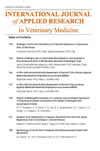Essential oils in broiler chicken diets as antimicrobial agents: Systematic review
4区 农林科学
Q4 Veterinary
International Journal of Applied Research in Veterinary Medicine
Pub Date : 2023-10-06
DOI:10.31893/avr.2023016
引用次数: 0
Abstract
The search for alternative ingredient options in the animal diet that have antimicrobial activity is due to many factors, such as pathogens increasing resistance and the presence of antibiotic residues in animal products consumed by humans. Therefore, there is a rising demand for natural additives that do not interfere with animal development or human health. Here, we compare studies on the use of essential oils as antimicrobial agents in broiler chicken diets. First, 90 papers were found using the key words “broilers”, “antimicrobial”, and “essential oils”. The second step was to select the papers according to the scales of Jadad and Medeiros and Stein, where six remaining researchers were selected to describe the antimicrobial activity of essential oils in response to enteric pathogens. Essential oils (EOS) have antimicrobial activity against different pathogens, such as E. coli, S. Enteritidis, S. Heidelberg and C. perfringens, and are considered alternatives to antibiotics used in animal production. The EOs that showed the greatest effectiveness were oregano essential oil (EO), cinnamaldehyde and thymol concentrates; when used together with additives such as sodium butyrate and xylanase, there was better antimicrobial action and improved animal performance. Ginger and carvacrol EOS also demonstrated antimicrobial activities, as did thymol, cinnamaldehyde and eucalyptus EO concentrates, but studies on the specific action of plant species that produce EOS for certain pathogens are still lacking; thus, the topic lacks an ongoing study addressing the addition of EOS in the feed of poultry production.肉鸡饲粮中精油作为抗菌剂:系统综述
在动物饮食中寻找具有抗菌活性的替代成分是由于许多因素,例如病原体的耐药性增强以及人类食用的动物产品中存在抗生素残留。因此,对不影响动物发育或人类健康的天然添加剂的需求不断增加。在这里,我们比较了在肉鸡日粮中使用精油作为抗菌剂的研究。首先,90篇论文使用了“肉鸡”、“抗菌”和“精油”等关键词。第二步是根据Jadad、Medeiros和Stein的标准选择论文,其中剩下的6名研究人员被选中描述精油对肠道病原体的抗菌活性。精油(EOS)对不同的病原体具有抗菌活性,如大肠杆菌、肠炎沙门氏菌、海德堡沙门氏菌和产气荚膜杆菌,被认为是动物生产中使用抗生素的替代品。效果最好的精油为牛至精油、肉桂醛和百里香酚浓缩液;与丁酸钠、木聚糖酶等添加剂配合使用,具有较好的抗菌作用,提高了动物生产性能。生姜和香芹酚EOS也表现出抗菌活性,百里酚、肉桂醛和桉树EO浓缩液也表现出抗菌活性,但对产生EOS的植物物种对某些病原体的具体作用的研究仍然缺乏;因此,该主题缺乏正在进行的关于在家禽生产饲料中添加EOS的研究。
本文章由计算机程序翻译,如有差异,请以英文原文为准。
求助全文
约1分钟内获得全文
求助全文
来源期刊
自引率
0.00%
发文量
1
审稿时长
3 months
期刊介绍:
The International Journal of Applied Research in Veterinary Medicine promotes excellence in the clinical practice of veterinary medicine by disseminating fundamental scientific, diagnostic, and treatment knowledge gained from prospective and retrospective research in a timely manner. The Journal fulfills its mission through rapid peer review of each submitted article, and publication of all articles within 90 days of acceptance. All published articles meet the standards of Balance, Independence, Objectivity and Scientific Rigor.

 求助内容:
求助内容: 应助结果提醒方式:
应助结果提醒方式:


